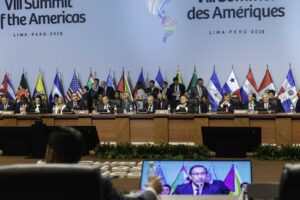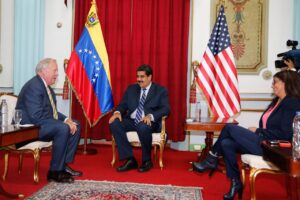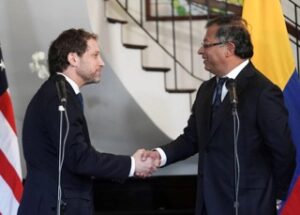
LIMA, PERU – 2018: Summit of the Americas Conference (Photo by Juan Manuel Herrera/OAS)
Overview
Economic aid provided to South America over the past two decades has primarily focused on democracy assistance and development across states such as Venezuela, Colombia, and Brazil. Recent crises pertaining to inflation in Venezuela due to authoritarian rule of dictators, such as Nicolás Madura, have prompted the United States to assist financially-plagued states.
On the contrary, many Venezuelan protests (2014, 2017, and 2018) pertaining to urban faults such as heightened rates of crime and food shortages paved the way for the United States to force chronic embargoes that prevented industries such as petroleum from flourishing in Venezuela. This dynamic relationship between the United States and South American states is important in generalizing larger trends in United States aid distribution across Latin America.

WASHINGTON D.C., U.S. – JUNE 2016: Venezuelan President Nicolas Maduro, pictured in center, met with the U.S. Under Secretary of State for Political Affairs, Thomas Shannon in Caracas to discuss future financial bilateral agreements between the Venezuela and U.S. (Photo by Zuma’s Press)
Venezuela
Aid – Humanitarian efforts in Venezuela have been increasing exponentially, even over the past two years. In 2021, the United States provided $38.0 million USD in aid to Venezuela to stimulate production for essential humanitarian supplies on a domestic level. This year, Venezuelan officials requested $55.0 million USD, which reflects a continued dependency on the United States for economic help. However, with this aid comes failed debt payments for the provisional aid that the United States provides. In 2018 alone, the Venezuelan economy contracted by 11.9%, which is preposterous considering a $350.0 billion USD economy can decline by almost $40.0 billion USD in a single year.
Embargoes – The Trump administration in the United States brought about strict conditions on a global level for embargoes and sanctions, whether said sanctions were related to goods and services or the immigration of peoples. In August of 2017, President Trump signed an executive order which barred banks in the United States from purchasing Venezuelan debt bonds. In other words, any debt that Venezuela was trying to sell or put off, which was purchased by large corporations with immense capital in the United States, was not able to be purchased anymore. This posed issues for the banks because large petroleum companies, such as PDVSA (Venezuela’s largest petroleum company) was not able to sell off debt, and therefore, was not able to produce as much. Because Venezuela as a nation is the tenth highest exporter of petroleum on a global scale, production and export levels of petroleum through top companies such as PDVSA are essential in maintaining a steady economy. Recent alleviation on these sanctions by the Biden administration has caused the Venezuelan economy to rebound, with reputable sources including Credit Suisse predicting that the Venezuelan GDP can increase by as much as 20% now that Maduro-related sanctions are lifted.

BOGOTA, COLOMBIA – JULY 2022: U.S. National Dept. Security Advisor Jonathan Finer and Colombia’s President-Elect, Gustavo Petro, shake hands after a meeting (Photo by Reuters)
Colombia
Aid – Primary legislation that has occurred between the United States and Colombia took place during the Obama administration, when the Trade Promotion Agreement of 2012 (TPA) was enforced. Over the past 20 years, there was a major uprising amongst the Revolutionary Armed Forces of Colombia (RAFC) and the Colombian government. With a peace treaty in 2016 dispelling any tension between RAFC and the Colombian government, a flourishing democracy was allowed to grow. In an effort to support democracy and peace implementation, the United States has funneled over $1.0 billion USD to the Colombian government since 2016. Most recently, the United States provided $20.6 million USD to aiding health surveillance and water quality during the COVID-19 pandemic within large cities such as Medellin, Colombia.
The most important piece of economic legislation between the two states was the above mentioned TPA. Since the TPA was set in place in 2012, tariffs between Colombia and the United States have been completely eliminated, which has fueled social and environmental maturation within bilateral trade patterns of the two states. Agricultural exports from the United States have doubled since the TPA was introduced.
Working Together – When referencing economic aid, the United States and Colombia worked together in providing bilateral aid to Venezuela strictly through geopolitics. The United States and Colombia both had similar goals of usurping President Nicolas Maduro of Venezuela. During his rule, he was famous for his operation Liberation of the People, where he utilized Venezuelan security forces to brutalize and murder approximately 4000 citizens annually. With a similar goal in mind to stop a liberalization agenda through violence, the United States has donated $700.0 million USD along with Colombian donations, with a goal of aiding the 1.8 million refugees living in Colombia, along with future refugees who seek political asylum from the Maduro government and inflation.
Brazil
Working Together – Due to the advanced nature of Brazil’s economy and flourishing domestic trade capacity, most of the cooperation and bilateral agreements between Brazil and the United States relate to larger world projects that encompass social and environmental concerns. Through private and public sectors, the United States has aided Brazil with over $110.0 million USD regarding combating the COVID-19 pandemic, as well as $67.2 billion USD of current investment within the Brazil economy and aircraft industry (Brazil’s main export). Anticorruption acts are in place with bilateral trade agreements amongst both countries as of 2011, primarily to ensure that the goal of net-carbon emissions within the Amazon is reached by 2050. Neither country is dependent on each other, and now works together as flourishing economies to lift each other up, as well as states in close proximity to them, due to both belonging to the OAS.
What’s next? – In recent news that Former President Jair Bolsonaro has been elected out of office in Brazil, it is intriguing to see how bilateral trade agreements will either stay constant or shift between the United States and Brazil.
Extraneous Aid
Who else? – In states with less ongoing political controversy, the United States has maintained donations of economic aid with the goal of improving the lives of ordinary citizens. For example, Bolivians have been receiving United States’ based economic aid since 1964 to improve health care quality of the working class. These states are primarily located in the western half of South America, including primarily Bolivia, Chile and Peru.
Recent Comments